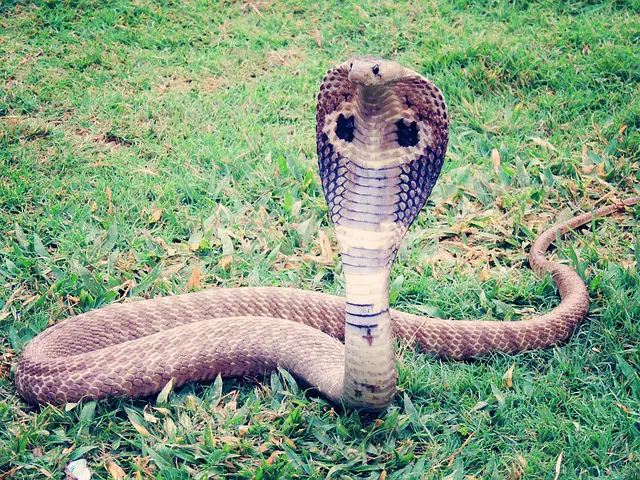Baby cobras are a fascinating subject for many people, especially those interested in snakes. One common question that people ask is when baby cobras have venom. This is an important question to answer because it can help people better understand the behavior and development of these creatures.
According to experts, baby cobras are born with venom, less potent than adult cobras. So while baby cobras can still be dangerous, they are not as deadly as their adult counterparts. It is also worth noting that baby cobras are typically timider and less aggressive than adult cobras, making them easier to handle in certain situations.
When Do Baby Cobras Develop Venom?
Baby cobras, also known as hatchlings, are born with venom glands, but their venom is not fully developed at birth. As a result, it takes time for their venom to become potent enough to cause harm to their prey or predators.
Factors Affecting Venom Development
Several factors affect the development of venom in baby cobras. One of the most important factors is the species of cobra. Different species of cobras have different rates of venom development. For example, the king cobra, one of the largest venomous snakes in the world, can produce lethal venom within a few weeks of hatching.
Other factors that affect venom development include the temperature and humidity of the environment, food availability, and the baby cobra’s health. For example, if a baby cobra is malnourished or sick, its venom may take longer to develop.
How Venom is Produced in Baby Cobras
Venom is produced in the venom glands of baby cobras. These glands are located behind the eyes and are connected to the fangs through ducts. When a baby cobra bites, muscles in the venom glands contract, forcing venom through the ducts and into the fangs. The venom is then injected into the prey or predator.
Initially, the venom of baby cobras is not as potent as adult cobras. It contains lower toxins and enzymes, so it may not be lethal to humans or larger animals. However, as the baby cobra grows and matures, its venom becomes more potent and can cause severe harm or even death.
Why Do Baby Cobras Have Venom?
As mentioned earlier, baby cobras are born with fully functional venom glands and fangs that can deliver a potent dose of venom. But why do baby cobras have venom in the first place?
One theory is that venom serves as a defense mechanism for baby cobras. Being small and vulnerable, baby cobras risk being attacked and eaten by predators. Venom allows baby cobras to defend themselves and deter predators from attacking them.
Another theory is that venom helps baby cobras to hunt and feed. Baby cobras are not strong enough to overpower larger prey, so venom helps them to immobilize and kill their prey. This allows baby cobras to feed and grow, eventually becoming strong enough to hunt without venom.
It’s important to note that venom can be dangerous and even deadly, especially for highly venomous snakes like cobras. While baby cobras may use venom for defense and hunting, it’s essential to exercise caution and avoid handling or approaching them.
What Happens If a Baby Cobra Bites?
Symptoms of a Baby Cobra Bite
When a baby cobra bites, it will inject venom into the victim’s body. Venom is a neurotoxin that can cause paralysis and respiratory failure, which can be fatal in severe cases. The symptoms of a baby cobra bite can vary depending on the amount of venom injected, the location of the bite, and the victim’s health condition.
The common symptoms of a baby cobra bite include:
- Pain at the site of the bite
- Swelling and redness
- Nausea and vomiting
- Dizziness and headache
- Difficulty breathing
- Blurred vision
- Convulsions and tremors
Treatment for Baby Cobra Bite
If a baby cobra bites someone, it is essential to seek medical attention immediately. The first aid treatment for a baby cobra bite includes:
- Keep the victim calm and still to slow down the spread of venom.
- Remove any tight clothing or jewelry near the bite area.
- Wash the bite wound with soap and water.
- Apply a pressure immobilization bandage to the affected limb to slow down the spread of venom.
- Transport the victim to the hospital as soon as possible.
At the hospital, the medical team will provide further treatment, which may include:
- Administering antivenom to neutralize the venom.
- Providing oxygen therapy to help the victim breathe.
- Monitoring the victim’s vital signs, such as heart rate, blood pressure, and breathing rate.
- Performing a blood test to check the victim’s kidney and liver function.
- Providing supportive care, such as pain relief medication and intravenous fluids.
Conclusion
Based on the research and findings discussed in this article, it can be concluded that baby cobras are indeed born with venom. Furthermore, the venom glands of baby cobras are fully functional at birth and capable of delivering venomous bites.
It is important to note that baby cobras are not necessarily more dangerous than adult cobras. While their venom may be just as potent, baby cobras are smaller, delivering a smaller amount of venom with their bites. However, it is still important to exercise caution around baby cobras and to seek medical attention immediately if bitten.
As with all venomous snakes, it is essential to take appropriate precautions when living or working in areas where cobras are present. This includes wearing protective clothing and footwear, being aware of your surroundings, and avoiding contact with snakes whenever possible.




